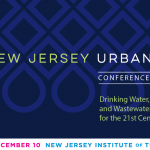New Jersey Future Blog
Slow Growth, Old Infrastructure Mean a Need for Innovation and Reinvestment
June 13th, 2013 by Peter Kasabach
To learn more about rebuilding our infrastructure post-Sandy, consider attending the NJ Spotlight conference on this topic tomorrow, Friday, June 14, at the Trenton War Memorial, 8:45 a.m. – 3:00 p.m.
 At its annual meeting June 6, the New Jersey Utilities Association (NJUA) hosted a panel titled, “What will New Jersey Look Like in the Future, and What Does that Mean for New Jersey Utilities?”
At its annual meeting June 6, the New Jersey Utilities Association (NJUA) hosted a panel titled, “What will New Jersey Look Like in the Future, and What Does that Mean for New Jersey Utilities?”
The panel was moderated by David Baker, the president of New Jersey American Water, and included panelists Joseph Fiordaliso, commissioner of the Board of Public Utilities; Clinton Andrews from Rutgers University; Brendan Livingston from Rowan University and Peter Kasabach from New Jersey Future.
Among the major points made by the panelists:
- New Jersey is growing more slowly compared to the rest of the country, and this is unlikely to change anytime soon.
- The Baby Boom and Millennial generations are the largest population cohorts and are driving where and what type of housing will be produced. Both these groups are seeking to live in compact, walkable communities. And where the workforce wants to be, the jobs often follow.
- The growth that is taking place has shifted away from decades-old sprawl patterns and is moving toward repopulating our towns, cities and suburban centers, especially those around train stations and institutions of higher education. This was further reinforced in this June 13 report on the latest census figures. This means investment in infrastructure will focus on reinvestment.
- Superstorm Sandy has awakened us to a new reality about needing to plan our infrastructure with sea level rise and other natural hazards in mind.
- Technological change in the utility and infrastructure industries can drive efficiencies and will dictate the new balance of infrastructure types that will serve New Jersey in the future.
- This is the time for the utility industry to be bold and innovate. It’s time for New Jersey to lead the way in new technologies and new ways of thinking about our infrastructure.
Full presentations are available here: Livingston-Rowan, Kasabach-New Jersey Future, Andrews-Rutgers.

















Unfortunately bullet points 2 and 3 are somewhat misleading. I agree that the draw of McMansions has waned, but he slower growth in growth area suburbs has nothing to do with demand characteristics. These are towns famous for fighting any growth and there haven’t been housing allocations now for 13 years. There is no supply of “middle density” housing or rental flats, and hence, no growth. Where conversion projects occurred, there is growth. And the attitudes of Millennials almost exactly mirrors the attitudes of Boomers at the same age — assuming that Mills will stay the same forever ignores life-cycle effects on demand patterns. Imputing desire/demand to census data without actually analyzing supply and buyer attitudes is a recipe for poor policy making. That said, I applaud the focus on renewing our infrastructure — we’ve waited far too long.